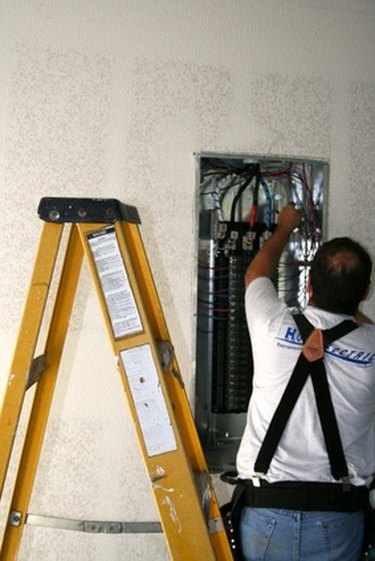For homeowners without access to municipal sewage systems, septic tanks treat and dispose of waste products. Homeowners are responsible for the maintenance and care of the septic system, sometimes including installation. In some geographical areas, it may be necessary to install a septic tank in an area that has a higher elevation than that of the drainage basin. In these instances, a septic effluent pump is also necessary to pump sewage from one chamber of the septic tank to a distribution tank to ensure that the septic system functions properly.

Video of the Day
Things You'll Need
Septic Effluent Pump
14-Gauge Electrical Wire
Shovel
20-Amp Gfi Breaker
Pipe Cleaner
Plumber Pipe Dope
Drainage Pipe
12-Gauge Electrical Wire
High Water Alarm
Conduit
Junction Box
15-Amp Standard Breaker
Installing Circuit Breakers
Step 1
Switch the main breakers inside the electrical panel to the "Off" position. Turn off the main disconnect at the meter as well. Use a flashlight or headlamp to see while installing the circuit breakers.
Video of the Day
Step 2
Install the 20-AMP GFI and 15-AMP standard circuit breakers using existing breaker box. Look for a black circuit wire held in place with a screw. Loosen the screw and connect the black circuit wire to the breaker, and then tighten the screw back in place. For the GFI breaker, there is a white neutral wire interwoven with the black circuit wire -- connect this to the breaker as well.
Step 3

Plug the circuit breakers into the breaker box by holding them at an angle with the notched side towards the metal bar and pushing them into place. The notched side of each circuit breaker will slide into place. The contacts on the back of the breaker connect with the metal bus bars in each breaker slot.
Underground Wiring and Outlet Installation
Step 1
Mount a junction box and a 20-AMP outlet to a 4x4 post near the septic tank. The outlet is for the septic pump, and the junction box is for the high water alarm float wires. Bury the post at least 16 inches, and secure it with a small amount of concrete.
Step 2
Dig a 2-foot trench from the septic tank back to the breaker box for underground wiring. Use a shovel or heavy machinery, depending upon the distance. Retain a contractor for digging trenches, if desired.
Step 3
Connect 12-gauge wire to 20-AMP outlet, and run 14-gauge wire to the junction box mounted on the post. The other ends of the two wires connect to the breakers in the breaker box. Run both wires through conduit. The 12-gauge wire that comes from the outlet for the sump pump connects to the 20-AMP GFI breaker. The 14-gauge wire used for the alarm float wiring connects to the standard breaker.
Pump and Alarm Setup
Step 1
Use tie strap or included materials to secure float switch for high water alarm inside septic tank. Secure the float switch at desired water level height. Float switch wiring will run to junction box on post and connect to 14-gauge wire that runs back to the breaker box. Install the remainder of the high water alarm components according to manufacturer specifications.
Step 2
Connect discharge pipe to outlet of submersible septic pump. Clean the pipe should with pipe cleaner and allow it to dry completely before securing to the pump. Use pipe dope and fittings to attach the pipe to the pump. The pipe should be the same length as the height of the septic tank, and the other end of the pipe will connect to the drainage pipe going to the distribution tank once the pump is in place.
Step 3
Attach a rope or cable to septic effluent pump and lower the pump into the tank. Secure the rope or cable to a nearby post. Connect the top portion of the drainage pipe to the section of drainage pipe going to the distribution tank, and allow pipe dope to fully dry before operating the system.
Tip
Seal off all connector boxes and couplings of the conduit run with silicone to prevent corrosion, water damage and damage caused by pests. Run conduit from the ground to the outlet and junction box for the pump and float wires to make the area waterproof. Have a building or plumbing inspector check the installation prior to operating the system.
Warning
Do not turn the breakers on until the entire septic pump installation is complete. When installing circuit breakers, always avoid contact with the main circuit bus bar inside the electrical circuit. This bar can remain energized even when the power is off. Electrical and plumbing work should be done by contractors whenever there is any doubt about personal safety.